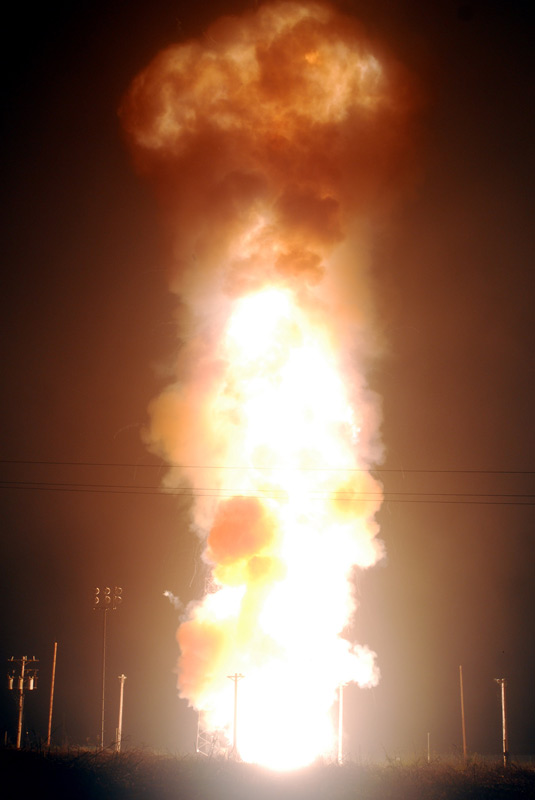Air Force Launches Ballistic Missile In Suborbital Test

The United States Air Force launched an intercontinentalballistic missile (ICBM) on a test flight early Wednesday, sending the weapon on a suborbital trajectory that reached thousandsof miles downrange over the Pacific Ocean.
The Minuteman 3 ICBM blasted off from a silo at California'sVandenberg Air Force Base at 3:40 a.m. EDT (0740 GMT) on routine test flightthat was monitored by analysts at the U.S. Department of Defense and theDepartment of Energy. Data from the test will be used to determine thereadiness of the U.S. military's ICBM fleet.
The launch sent the Minuteman 3's single re-entry testvehicle about 4,200 miles (6,759 km) across the Pacific Ocean to apre-designated target near the Kwajalein Atoll in the Marshall Islands. Theatoll is home to the U.S. Army's Ronald Reagan Ballistic Missile Defense TestSite.
"These launches teach us a great deal and require ateam approach," said Air Force Col. Carl DeKemper, the 576th Flight TestSquadron commander and mission director, in a statement. "The launch waspart of our continuous self-assessment of the technical and weapons systemexpertise of our Airmen and the powerful capability of the ICBM fleet."
Wednesday's test marked the second this month of the AirForce's Minuteman 3 missile. An earlier test launched from Vandenberg on June16. ?
The Minuteman 3 intercontinentalballistic missiles have a range of more than 6,000 miles (9,656km) and can travel at speeds of up to Mach 23 (15,000 mph or 24,000 kph) andreach heights of up to 700 miles (1,120 km) above Earth.
That means that Minuteman 3 missiles fly higher than theInternational Space Station, which orbits Earth at an altitude of about 220miles (354 km), when they hit the peak of their trajectories.
Breaking space news, the latest updates on rocket launches, skywatching events and more!
Minuteman 3 ICBMs were first produced in June 1970, withproduction stopping in December 1978, according to the Air Force fact sheet. TheMinuteman weapons system was first conceived of in the late 1950s as a strategicweapon with an intercontinental range to serve as strategic deterrent forcefor the U.S. military.
The missiles are housed in hardened underground silos andare watched over 24 hours a day by launch crews consisting of two officers pershift. The first Minuteman 1 missiles were deployed in the late 1960s.
Today, Air Force's Minuteman weapon arsenal consists of450 Minuteman 3 ?missiles located at bases in Montana, Wyoming and NorthDakota, according to an Air Force fact sheet. The missiles are made of threedistinct stages that, when assembled, stand about 60 feet (18 meters) tall andweigh 79,432 pounds (32,158 kg).
The Air Force has also participated in a series of other testlaunches this year, including the April launch of the roboticX-37B space plane ? dubbed Orbital Test Vehicle 1 ? fromFlorida. That vehicle is still in Earth orbit today. [X-37Bspacecraft photos.]
The ICBM test flight also marked the 1,900th launch fromVandenberg Air Force Base since 1957. ?The Air Force's 576thFlight Test Squadron, 341st Missile Wing and 30th Space Wing all contributed tothe test flight, Air Force officials said.

Tariq is the award-winning Editor-in-Chief of Space.com and joined the team in 2001. He covers human spaceflight, as well as skywatching and entertainment. He became Space.com's Editor-in-Chief in 2019. Before joining Space.com, Tariq was a staff reporter for The Los Angeles Times covering education and city beats in La Habra, Fullerton and Huntington Beach. He's a recipient of the 2022 Harry Kolcum Award for excellence in space reporting and the 2025 Space Pioneer Award from the National Space Society. He is an Eagle Scout and Space Camp alum with journalism degrees from the USC and NYU. You can find Tariq at Space.com and as the co-host to the This Week In Space podcast on the TWiT network. To see his latest project, you can follow Tariq on Twitter @tariqjmalik.
